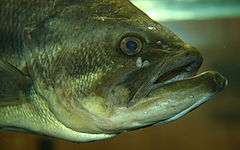Largemouth bass
This article needs additional citations for verification. (October 2008) |
| Largemouth Bass | |
|---|---|

| |
| Scientific classification | |
| Kingdom: | |
| Phylum: | |
| Class: | |
| Order: | |
| Family: | |
| Genus: | |
| Species: | M. salmoides
|
| Binomial name | |
| Micropterus salmoides | |
The largemouth bass (Micropterus salmoides) is a species of fish in the sunfish family native to North America . It is also known as widemouth bass, bigmouth, black bass, bucketmouth, Florida bass, Florida largemouth, green bass, green trout, linesides, Oswego bass, southern largemouth and (paradoxically) northern largemouth.[2] The largemouth bass is the state fish of Alabama[3] (official freshwater fish), Georgia,[4] Mississippi,[5] Florida[6] (state freshwater fish), and Tennessee[7] (official sport fish).
Physical description
The largemouth is an olive green fish, marked by a series of dark, sometimes black, blotches forming a jagged horizontal stripe along each flank. The upper jaw (maxilla) of a largemouth bass extends beyond the rear margin of the orbit.[8] In comparison to age a female bass is larger than a male.[9] The largemouth is the largest of the black basses, reaching a maximum recorded overall length of 29.5 in (75 cm)*[10] and a maximum recorded weight of 25 pounds 1 ounce (11.4 kg).[10] The fish lives 16 years on average.[11]
Forage
The juvenile largemouth bass consumes mostly small bait fish, scuds, small shrimp, and insects. Adults consume smaller fish (bluegill), snails, crawfish (crayfish), frogs, snakes, salamanders, bats and even small water birds, mammals, and baby alligators.[12] In larger lakes and reservoirs, adult bass occupy deeper water than younger fish, and shift to a diet consisting almost entirely of smaller fish like shad, trout, ciscoes, shiners, and sunfish. Prey items can be as large as 25 to 35% of the bass's body length. Studies of prey utilization by largemouths show that in weedy waters, bass grow more slowly due to difficulty in acquiring prey. Less weed cover allows bass to more easily find and catch prey, but this consists of more open-water baitfish. Paradoxically, with little or no cover, bass can devastate the prey population and starve or get stunted. Fisheries managers need to take all these factors into consideration when designing regulations for specific bodies of water. Under overhead cover such as overhanging banks, brush, or submerged structure such as weedbeds, points, humps, ridges, and drop-offs, the largemouth bass will use its senses of hearing, sight, vibration, and smell to attack and seize its prey. It can sometimes hold up to 5 sunfish in its mouth. Adult largemouth generally are apex predators within their habitat, but they are preyed upon by many animals while young.[13]
Angling
| Fly fishing targets |
|---|
 |
| See also |
Largemouth are keenly sought after by anglers and are noted for the excitement of their fight. The fish will often become airborne in their effort to throw the hook, but many say that their cousin species, the smallmouth bass, can beat them pound for pound. Anglers most often fish for largemouth bass with lures such as plastic worms (and other plastic baits), jigs, crankbaits and spinnerbaits. A recent trend is the use of large swimbaits to target trophy bass that often forage on juvenile rainbow trout in California. Live bait, such as nightcrawlers, minnows, frogs, or crawfish can also be productive. In fact, large golden shiners are one of the best things to use to catch trophy bass, especially when they are sluggish in the heat of summer time or in the cold of winter. Largemouth bass are known to take any bait they consider alive.[citation needed]
There is a strong cultural pressure among largemouth bass anglers which encourages the fish's live release, especially the larger specimens. Largemouth bass, if handled with care, respond well to catch and release; many studies have shown specimens which have survived being hooked and released multiple times.
The Largemouth Bass has been known to exist in many of the lower 48 states of the U.S. Although it is most popular in the southeastern states, many different varieties of the largemouth bass can be found in the north and western regions.They are an invasive species in the Canadian Province of New Brunswick,bringing in sea lice and eating native fish. [citation needed]
Up until 2010, the International Game Fish Association (IGFA) officially recognized the heaviest largemouth bass on record as having been caught by George W. Perry at Montgomery Lake in Telfair County, Georgia, on June 2, 1932. The fish weighed 10 kg (22¼ lb). A largemouth bass weighing 25 pounds 1 ounce was caught by Mac Weakley in Escondido, California's Dixon Lake on March 20, 2006, but Weakley inadvertently foul-hooked the fish and released it without submitting it for a IGFA record.[10] On July 10, 2009, Manabu Kurita from Aichi, Japan caught a 22 pound, 4 ounce largemouth bass in Lake Biwa. The IGFA declared that the 77 year old record had been tied.[14].
References
- ^ Froese, Rainer; Pauly, Daniel (eds.). "Micropterus salmoides". FishBase. February 2010 version.
- ^ "Black Bass". Florida Fish and Wildlife Conservation Commission: Division of Freshwater Fisheries. Retrieved 2007-03-17.
- ^ "Official Alabama Freshwater Fish". Alabama Emblems, Symbols and Honors. Alabama Department of Archives & History. 2008-02-13. Retrieved 2007-05-09.[dead link]
- ^ "Georgia State Symbols". State of Georgia. Retrieved 2008-05-09.
- ^ "State Symbols". State of Mississippi. Retrieved 2008-05-09.
- ^ "State Freshwater Fish". State of Florida. Retrieved 2008-05-09.
- ^ "State Symbols". State of Tennessee. Retrieved 2008-05-09.
- ^ In-Fisherman Largemouth Bass Description
- ^ Fresh water fish identification Largemouth bass.http://myfwc.com/wildlifehabitats/Freshwaterfish_LargemouthBass.htm. 6-23-10
- ^ a b c "Escondido's world-famous bass found dead". San Diego Union-Tribune. Retrieved 2009-05-27.
- ^ "Largemouth Bass (Micropterus salmoides)". Texas Parks and Wildlife. Retrieved 2008-10-03.
- ^ YouTube - Fish vs Alligator
- ^ In-Fisherman - Largemouth Bass Forage
- ^ IGFA press release.,
